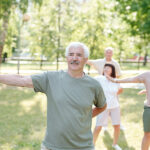By David Blyweiss, M.D., Advanced Natural Wellness
August 06, 2014
- What we learned from our ancestors
- Is too much exercise aging you?
- Anti-aging can be a walk in the park
If you’re anything like my patients, the word “exercise” makes you cringe. You might feel guilty for not making more time for it. Or maybe you just dislike going to the gym or find it boring to perform repetitive movements.
Well, it might surprise you to learn that the modern-day habit of exercising is unnatural. We weren’t made to “exercise”… we were made to move!
Just think about it. Our ancestors didn’t run in place on treadmills for 45 minutes at a time, pump iron or balance on big balls.
They were simply on the move, from sunrise until sunset. They ran to escape danger or chase down dinner. They were on their feet all day – stooping, bending and climbing to gather fresh fruits and vegetables. And at the end of long, physically active days, they danced and played music around a fire.
MD Exposes the Hidden Danger to Your Eyes

When your eyesight starts to fail, it's a real problem. Suddenly you can't go to the grocery store... you can't get to the doctor if you have an emergency... you can't meet your friends for dinner…
Your "regular" doctor doesn't have time to keep up with the latest research. And the same goes for eye doctors. They go to school to learn how to fit you for glasses and contacts, but have no way of preventing the damage and loss of eyesight that threatens your freedom and independence.
Let me show you something that explains a LOT about how your eyes work.
In my FREE Special Report, I'll show you a HUGE, untapped resource for your eyes that safely and naturally restores clear, effortless eyesight.
Click here to get started...
These folks gently moved their bodies throughout the day, punctuated by a few short bursts of exertion. And that’s exactly what we should be doing.
It’s not just for your heart, weight and muscles. There’s much more to it than that.
You see, getting plenty of moderate physical activity every day protects your telomeres. These are the protective caps at the ends of your chromosomes.
But if you’re getting too much exercise – or very little activity at all – it may just speed up telomere shortening, and age you at the cellular level.
Over the years there has been plenty of evidence showing people who are more physically active have longer telomeres than those who are inactive. But until recently there has been very little data on the actual amount of activity required to maintain telomere length.
Here in my office, most of my active patients fall into one of two groups:
Constant movers. These folks never seem to sit, but they never seem to “exercise,” either. They’re always on the go. It doesn’t matter if they’re walking the dog, climbing stairs, working in the yard or heading out for a game of golf. Their bodies are gently in motion, all day long.
Are You Suffering From...
- Love handles and a pot belly
- Romance that isn't what it used to
- Forgetfulness and inattention
- Low (or no) strength and endurance
- A sex drive that's shifted into neutral...or worse
If so...you may have Mature Male Burnout. Click here to discover more about this unique condition and what you can do about it.
Workout warriors don’t move much at all during the day. But for an hour or two every morning or evening they perform vigorous workouts. These folks work up a heart-pounding sweat running for miles, doing jump-squats, bench presses and everything in between. I call these patients “workout warriors.”
Well, we’re now learning that too much vigorous exercise might not be any better than sitting when it comes to telomere length. And I’m not just talking about the folks who are running marathons or taking part in Iron Man competitions.
Overdoing it on the exercise can damage muscles. This, in turn, produces inflammation and oxidative stress, which are known factors when it comes to how quickly your telomeres shorten.
The key, then, is to get your physical activity in without causing excess damage, fatigue or stress in your muscles. And it’s pretty easy to do. You don’t have to knock yourself out, and there are plenty of ways to make it fun.
There are some very easy ways to start getting more activity into your day. Some of them are pretty straightforward, like taking the stairs instead of the elevators… or parking your car in the furthest row of the parking lot. Just get on your feet and get moving as much as possible.
If you’re new to the concept of getting your body in motion, I suggest starting off with a 30-minute walk each morning and evening. Go somewhere scenic that you’ll enjoy, like your local park. But instead of just strolling along leisurely for the full amount of time, add in a few 30- to 60-second bursts of intensity. That means picking up the pace or tossing in a little sprint every now and then… or maybe stopping to do a few jumping jacks.
And, by the way, it doesn’t matter how old you are. People who get moderate levels of physical activity in midlife have longer telomeres than those who are inactive or highly active. They also have a smaller proportion of shortened telomeres.
At the same time, you’ll be lowering your risk of type 2 diabetes, heart disease, stroke, lung disease, arthritis, dementia and obesity. Plus, it can help reduce your stress levels and help you sleep better at night.
If you’re feeling a little more adventurous, sporting activities like racquetball, tennis, basketball and softball are all great. They keep you moving. And all of them involve moments of intense exertion.
Take up bicycling, go swimming, join a dance class, work in the garden, play with your dog… anything that gets you up and moving.
Getting your body moving can be as fun as you make it. It may take some trial-and-error to find the right fit for you, but there truly is something for everyone out there. And the benefits are undeniable.
Sources:
Savela S, et al. “Physical activity in midlife and telomere length measured in old age.” Exp Gerontol. 2013 Jan;48(1):81-4.
Ludlow AT, et al. “Relationship between physical activity level, telomere length, and telomerase activity.” Med Sci Sports Exerc. 2008 Oct;40(10):1764-71.
“The benefits of regular walking for health, well‐being and the environment.” C3 Collaborating for Health. Sep 2012





